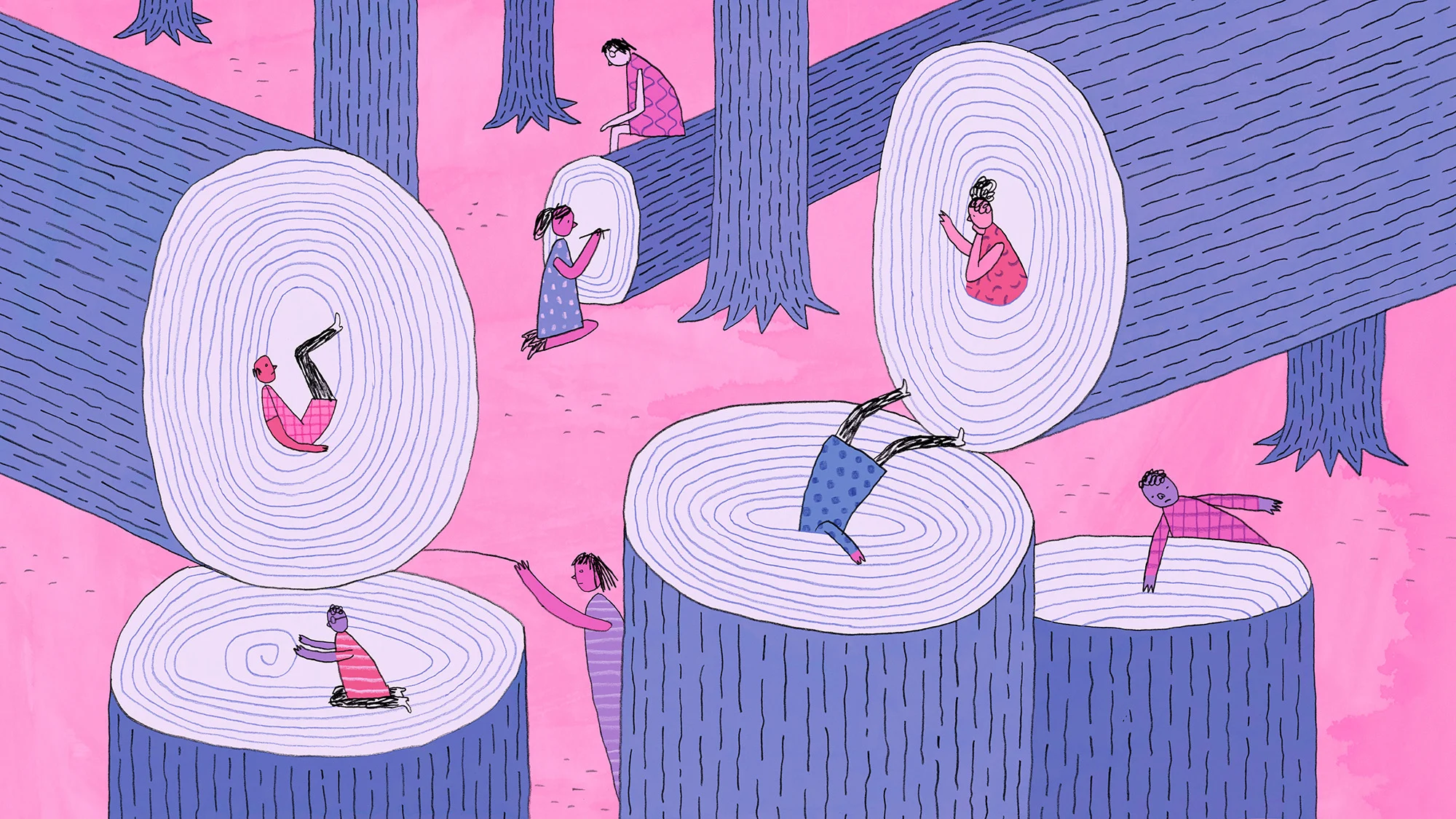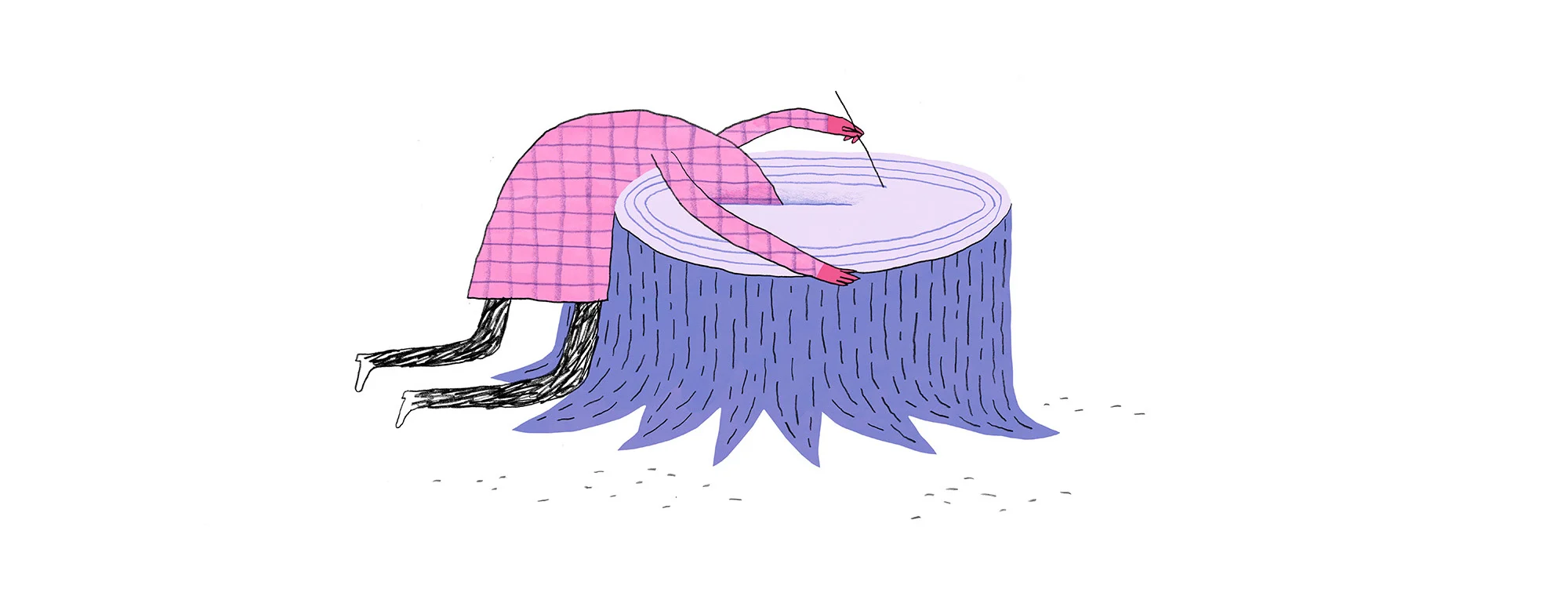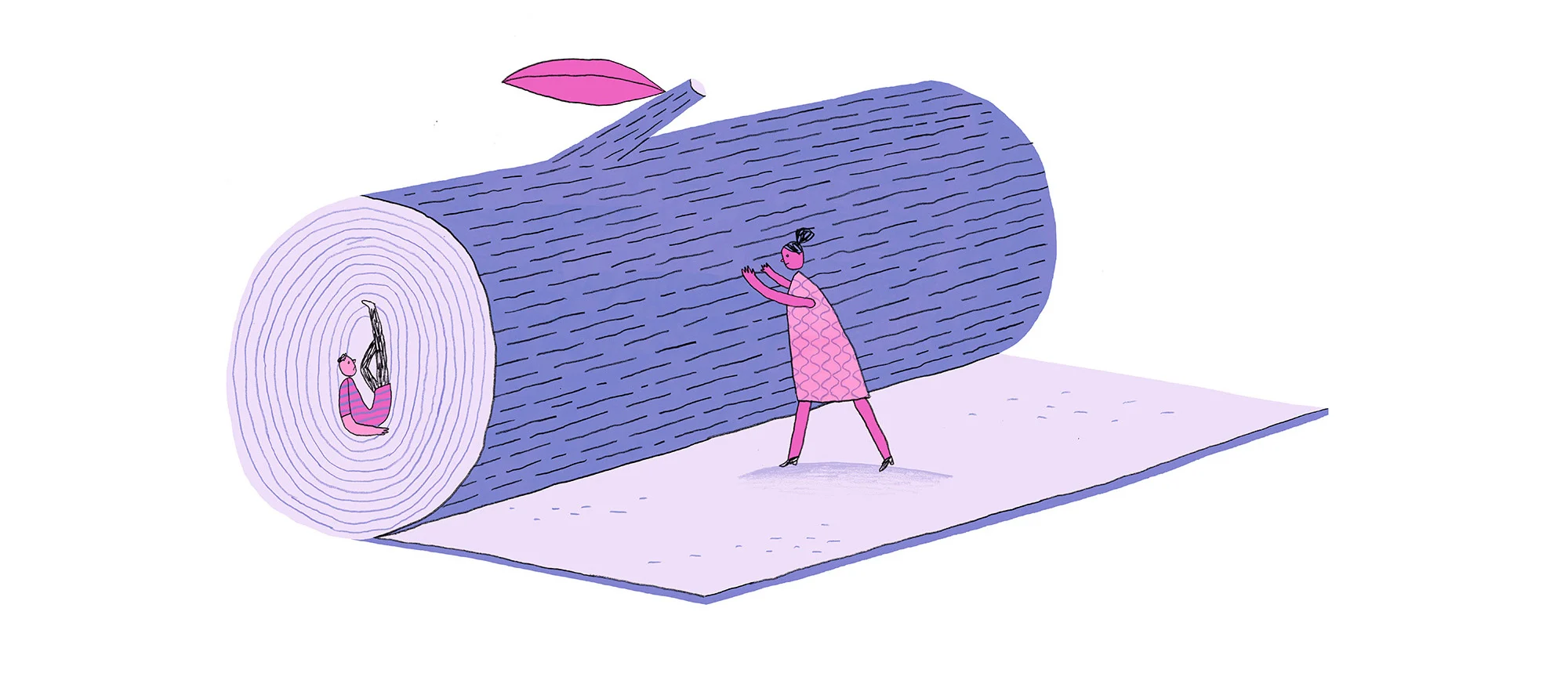

Beyond the tired clichés of sports cars, affairs and depression, what do we really know about the midlife crisis? Or, more importantly, how can our misconceptions be overturned to prove that it is not harmful, but actually something beautiful, revelatory and necessary?
experienced his own “crisis” at 50 and subsequently retrained as a psychotherapist. He now sees a number of clients facing their own difficulties in midlife and is helping them through it. He even wrote a book about his findings called “Midlife: Humanity’s Secret Weapon,” which is out now on Notting Hill Editions.
Here, Andrew explains what a midlife crisis really is, and how centuries of people going through their own can prove it’s not a time for death, but a time for tremendous rebirth, creative sparks and potential.
Illustrations by Brian Rea
When I had my midlife crisis, I went to bed for nine and a half weeks, laid prostrate through long days and even longer nights, feeling immeasurably sorry for myself. I had just celebrated my 50th birthday, but my sense of celebration was displaced by a strange uneasiness that within the course of a fortnight modulated into something much more troublesome. I felt overwhelmed by a disabling lassitude which deepened into an incapacitating depression. All the many blessings of my life were forgotten and I lay in bed, plagued by a range of disturbing anxieties and an inconsolable despair from which I felt I would never recover.
Yet two things seemed to give me a brief reprieve from this pervading torment: my daily telephone call with my 92-year-old therapist, and the time I spent each evening in the company of a series of individuals whom I admired. I somehow felt comforted when reading biographical accounts of the suffering they went through at peak moments of anguish and distress in their middle years.

I went all the way back to the earliest stirrings of Western culture, and considered the repeated calamities that befell Odysseus as he attempted to return home after the Trojan War. I read about Dante’s efforts to escape the “dark wood” of the Inferno and Purgatory into which he disappeared for so long. I reflected on Michelangelo’s collapse when he lost all hope in his doomed attempt to paint the Sistine Chapel ceiling. I read Beethoven’s “Heiligenstadt Testament”—partly a suicide note, partly an artistic mission statement, partly a cathartic exorcism—in which he decides whether to end his afflicted life or, despite his deafness, to try to achieve what he is certain he is capable of. I considered the breakdowns that Abraham Lincoln and Franklin D. Roosevelt experienced, which seemed to end all their political ambitions while also transforming them into two outstanding presidents that steered their country through a series of perilous crises.
I read about the miseries of Marie Curie, whose agony after the death of her beloved husband, Pierre, was made even worse when the French press and public attacked and humiliated her for finding comfort in the arms of her lover, Paul Langevin. Something similar happened to Mary Ann Evans, known to us today as George Eliot, who suffered inconsolable grief when her father died and found solace in the company of George Henry Lewes—an intimate relationship that received such savage criticism from friends and family that the couple left England and became a pair of vagrant exiles.
And there was Carl Gustav Jung, whose breakdown lasted five years, between 1913 to 1918, and of which he wrote: “These years were the most important of my life—in them everything was decided. It all began then.”
In reading the accounts of these notable individuals and how they battled through their midlife crises, I began to realize that these harrowing feelings were perhaps not just some arbitrary misery, but rather a transformative experience. They seemed to turn ordinary individuals into exceptional men and women who achieved not only significant outward success, but also a striking level of inner serenity when facing the later challenges of their lives. Perhaps these anxieties and depression that I was so overwhelmed by could become a portal into some new phase of life.
The outward circumstances of each midlife crisis is different, although in each person, the brain chemistry is remarkably similar. At such times of heightened agitation, our amygdala will drench our entire neural system with adrenaline, causing this fizz of anxiety. This high octane hormone is designed to make us run faster and jump higher, as our fight-or-flight response is ignited. Yet if we remain inactive, the adrenaline turns into a toxic substance called cortisol that depletes our serotonin and dopamine levels. These two neural hormones provide us with a sense of well-being and inner calm. Without these two chemicals, we become a mass of fears and perturbations, as the adrenaline and cortisol overwhelm us.

Yet there is much that can be done to relieve this misery. First, I am a great believer in antidepressant medication. In the course of a month, they can trigger the brain to start producing the vital serotonin and dopamine needed to staunch the toxic adrenaline and cortisol. As this happens, the depression and anxiety begin to lift and a kind of vacuum, or empty space, emerges. This is the moment when a nourishing relationship with a psychotherapist can begin the process of true transformation.
This capacity for transformation that the midlife crisis offers is within the grasp of us all. In my case, these experiences resulted in me retraining, and a few years later, I qualified and started practicing as a psychotherapist. This change of profession has given me immense fulfillment and satisfaction, as I’ve returned with my clients again and again to the challenging months and years that this strange midlife ordeal requires of us. It is a necessary rite of passage that we should not deflect or deny, as within its compass there is so much to be gained.
Rainer Maria Rilke wrote in his “Duino Elegies” of those for whom “sorrow is often the source of a blessed progress.” This could be a kind of mantra or leitmotif for the practice of psychotherapy. It is the grueling, demanding experiences of our lives, when we are stretched to our limit, that provide us with the opportunity to develop the finer aspects of our personalities and move towards what Abraham Lincoln called “the better angels of our nature.” And perhaps when these feelings of intense emotional discomfort are extreme enough, when our demons and the less attractive features of our character rise up from within us, we will seek the help and support of a psychotherapist.
If the midlife crisis can be explored, examined and overcome with the help of a successful therapeutic relationship, a range of benefits will slowly be accumulated. Our anxieties and depression will lift. The manner in which we conduct our closest relationships will be transformed. Our compassion will deepen as our self-centredness diminishes. Our capacity for humility will be extended. Our concerns about our mortality will diminish. Elements of our creativity which have lain dormant for years will be revealed. Our sense of soulfulness and our interest in spirituality will emerge. Such is the power of the kind of self-realization that can be facilitated by therapy, and which can be the eventual consequence of the midlife crisis.
As a practicing psychotherapist, it is clear that clients, for the most part, are looking for a kind of re-parenting. In fact, what the client is unconsciously looking for is a second experience of parental love. As the pioneering Hungarian psychoanalyst Sándor Ferenczi, friend and confidant of Freud, wrote in his 1932 clinical diary: “No analysis can succeed if we do not succeed in really loving the patient.”
As my own loving therapist repeatedly said to me during the ordeal of my own midlife crisis: “Andrew, you must trust in life, trust in life.” And in this second experience of parenting, having placed to one side all my defenses, as I lay in bed vulnerable and depleted, I learned that I should be more trusting of myself, of those closest to me, and life around me. And it seemed to work. Without giving up my work in the classical music business, I found the time and energy to study and qualify as a psychotherapist, building up a rewarding practice. And then, more recently, I was given the opportunity to write my first book, “Midlife: Humanity’s Secret Weapon,” and then to write this article.

During my now 20 years of psychotherapeutic practice, the majority of my clients have been caught in the mire of their midlife crises. What I have noticed when working with these individuals is that during our time together, as we move through these months of uncertainty, an innate and compelling pulse of creativity begins to emerge. This creative spirit, which I believe we all have, so often gets smothered in childhood or adolescence, as we are pushed and pulled in directions required by our upbringing and education.
This regimentation of our childhood experience so often demands a strict conformity, which forces that fragile bud of our creative imagination into the depths of our unconscious. And then in the great shake-up of the midlife crisis, that forgotten seed of our innovative, expressive, gifted nature seizes its opportunity and emerges into the light. So many of my clients in these febrile midlife circumstances have started to write, paint, compose or pick up some long-forgotten musical instrument. A number have turned to pottery and ceramics. Some become engrossed in gardening and horticulture. Others begin to widen their culinary talents and are compelled to bake bread or begin to cook elaborate meals for their friends and family. Others sew and knit, or produce tapestries, rugs and fashionable clothing. Some turn to jewelry or amateur dramatics or join a regular dance class. The range of creative expression is immense, but whatever this expressiveness might be, this pulse of reinvigorated energy will revitalize a life-enhancing element of our unique personality. The revival of this lost aspect of our authentic nature is profoundly enriching and helps us recover from our midlife ordeal refreshed, reinvigorated, and ready to grasp the full measure of the adventure ahead.
This recovery of our creative spirit is one of the many gifts that our exacting middle years will at some point offer us. This period of intense challenge is not a malign fate, punishing us for reasons we don’t understand. It is simply our own lives, our own inner nature reminding us that time is short and that we need to experience so much more than the safe, circumscribed, boundaried world that our life has become.

